Marvel’s Spider-Man Remastered PC Review – Great Power, Great Performance
Marvel’s Spider-Man Remastered PC Review
Marvel’s Spider-Man Remastered finally swings over to the PC, almost 4 years after it was initially released for the PlayStation 4 back in September 2018. Its release back then saw a number of accolades and awards, lauding its gameplay and representation of the webbed hero, eventually becoming a best-seller on the PS4.
In 2020, a Spider-Man Remastered version was released for the PS5, and while it was criticized for being available exclusively with the Ultimate Version of Miles Morales, it was still warmly received as a much-appreciated upgrade to an already fantastic experience.
The latest release sees the remastered version come to the PC, bringing with it the three-part DLC – The City That Never Sleeps – along with a variety of options to take advantage of the wide range of PC hardware available today.
As such, we’re taking a bit of a different approach this time, focusing on the new PC additions along with checking out the DualSense support included in the game.
Unfriendly Neighborhood
First off, let’s check out the system requirements for Spider-Man Remastered.

As you can see from the list, the specs are pretty demanding, especially considering that you’ll need at least a 3070 to go anywhere above the recommended settings. If you’re thirsty for that ray tracing goodness, you’ll need to upgrade as needed, especially with the CPU. It has to be stressed that this is only if you want the best visual experience, so you can turn some options off to make a compromise.
A couple of more requirements that pop out from the list are the 16GB of RAM along with the 75GB SSD requirement for anything above the minimum.
It’s understandable that not everyone can afford to play on max settings, but checking out both the minimum and recommended requirements, we can see that Insomniac Games and Nixxes Software have given us quite a reasonable list, only needing at least a 1060 to run the game at 1080p 60fps at medium graphical presets, and even lower to hit 720p 30fps at minimum.
Spider-Man Remastered also has a number of settings that will take advantage of your hardware, which you can see below:
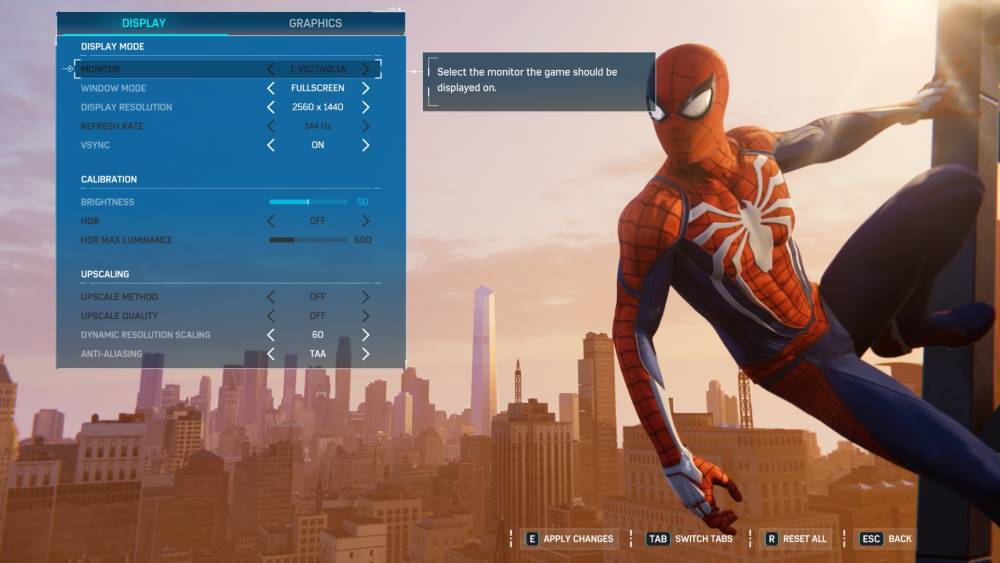
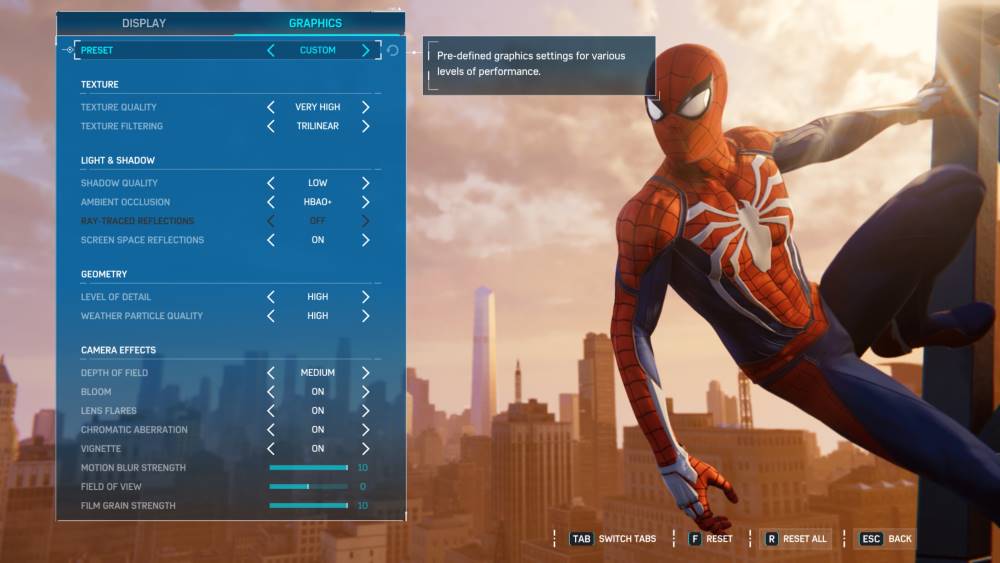
Players will get the standard suite of display and graphical options for Spider-Man Remastered, allowing the adjustment of the resolution, HDR, anti-aliasing, texture quality, shadow quality, depth of field, and much more.
Additionally, Spider-Man Remastered will include several new ray tracing and geometry options, which are not in the game as of writing but will be added by the time it goes live to the public. These options give the players more control over reflections and object density, further customizing the experience depending on the capabilities of your rig.
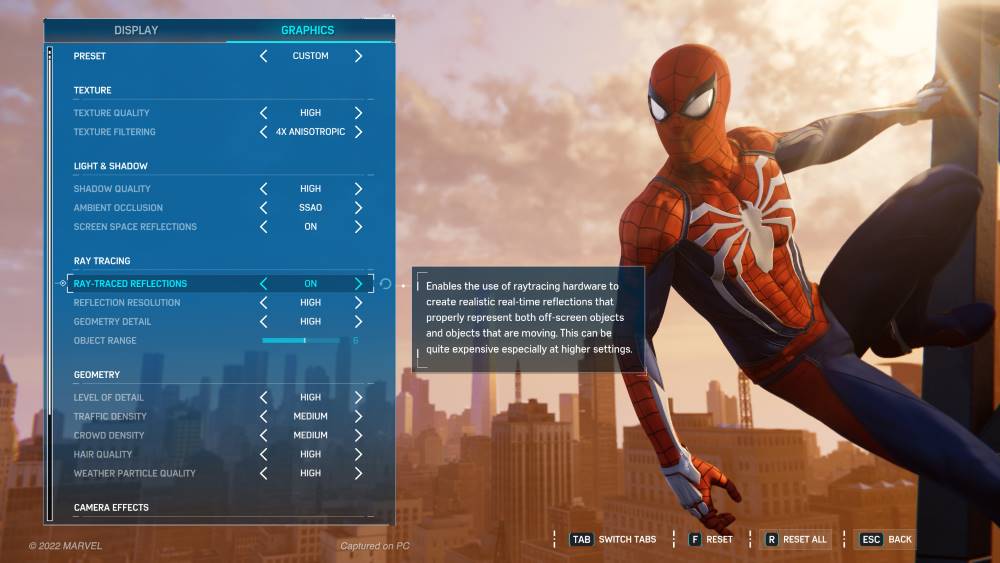
Also, the Insomniac Temporal Injection option is making its way to Spider-Man Remastered. This technology was already used back in the 2018 release to great effect and PC players will also see it here put to good use.
Needless to say, if your PC is up to the challenge, there’s definitely a lot to turn up here to make the game look as clean as a Peter Parker photograph.
Spidey DualSense is Tingling
One of the headlining features of Spider-Man Remastered for the PC is its DualSense support, something you can only fully experience using a wired connection.
And you’ll want to do so because the game is meant to be played on a controller. Using a keyboard and mouse is acceptable, especially since you can change the button mapping, but it just doesn’t feel the same way. We’re sure others will disagree, and while mileage may certainly vary, playing with any controller does wonders for the game in our opinion.
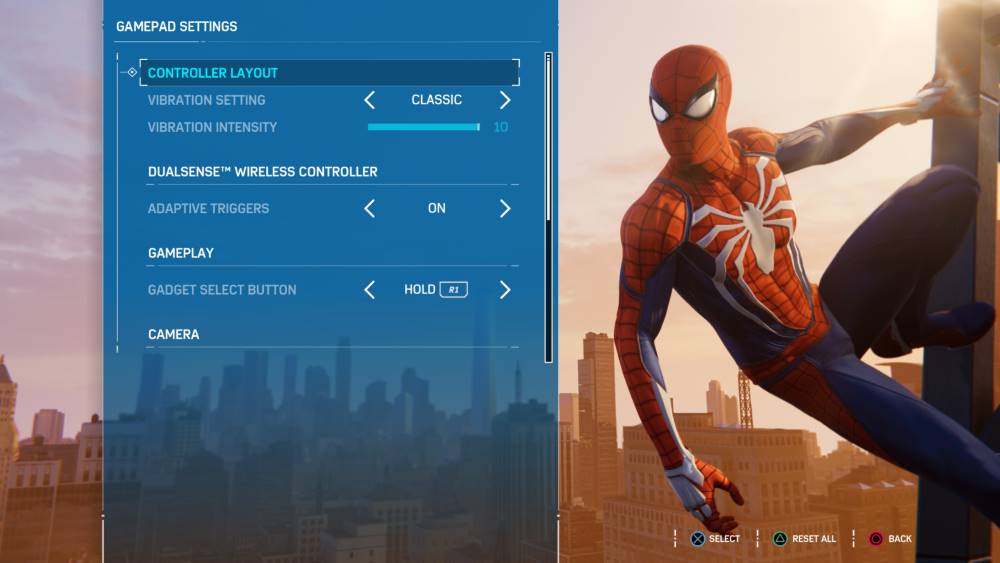
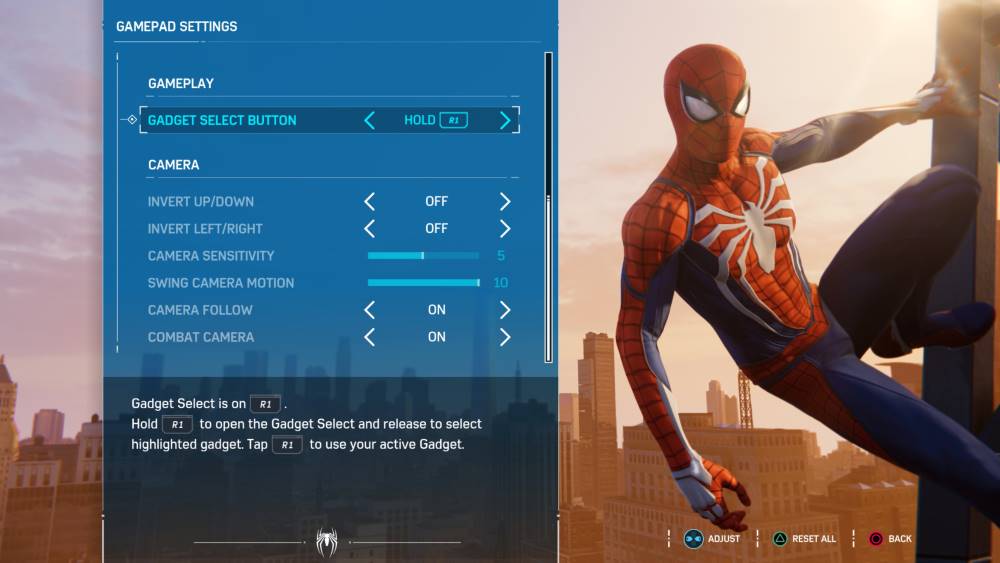

This is especially true with the DualSense, allowing for haptic feedback and adaptive trigger support, making every swing and punch felt. The adaptive triggers also aren’t as intrusive here, so there isn’t enough reason to turn them off unlike some other games on the PS5.
The choice is pretty obvious if we would be asked whether to play on KBM or controller. The feel and layout are much more intuitive, especially when web-swinging around the city. On default mapping along, R2 to swing just feels more natural than left shift, and even when you’ve changed up the settings, nothing really compares.
Much has been said about Insomniac Games’ use of these features on their PS5 counterparts, and PC players will finally get to feel the difference as long as they’re willing to sacrifice a wireless connection.
With Great Power Comes Great Performance
We tested the game with a fairly decent setup. Not the tops, but we’d imagine that many players might be looking at a similar range, especially considering the prices of parts these days:
- Ryzen 5 5600x, 16 GB DDR4 3600 RAM, NVIDIA 1650, 1TB NVMe SSD
Based on the spec sheet above, we should be hitting recommended pretty comfortably, and we can confirm that it hits the expected performance pretty well. Despite staying in the 1080p range (1440p is doable but with frame dips here and there), the visuals remained crisp, and if you’re not too much of a stickler for shadows and overall fidelity, the recommended settings at medium are perfectly playable.
Spider-Man Remastered has a setting called dynamic resolution scaling, which will allow players to hit a target frame rate at the expense of resolution. With our setup, we found that we could comfortably stay in the 60-90fps range at 1080p. When pushing it up to 1440p, hitting 90fps meant taking a drastic hit to resolution, and the jagged edges around Spider-Man’s suit and surroundings become immediately noticeable.
In a type of game such as Spider-Man Remastered, FPS was much more important to us over resolution, so hitting a stable 60fps was enough to satisfy our needs. We found a good balance at 1080p while hitting 90fps with our setup, and it proved to be quite the experience.
The game kept an almost steady frame rate for us, anywhere between 80-90fps during general gameplay. We would notice some dips during sequences with a lot of breakable environment objects and particles, putting us to the 70-75fps mark, but we would bounce back to 90 during regular and even open-world sequences.
All things considered, Spider-Man Remastered is a pretty impressive port, which we’ve come to expect from any Nixxes release. The build was stable, and we experienced no unusual crashes or bugs during our time with it. The game did hang on us when we tried pushing the settings to max, but of course, that was our fault more than anything else.
As of writing, Insomniac Games and Nixxes Software are continuing to improve the stability and performance of Spider-Man Remastered, especially with improvements to FSR 2.0 and DLSS for compatible systems. There is preliminary FSR support here, but further improvements are being added.
Sadly, one thing we didn’t get to try was the ultrawide experience, although we’ll be updating this review once we do!
As per the spec sheet, Spider-Man Remastered will support various screen sizes, ranging from 16:9, 16:10, 21:9, 32:9, and 48:9 resolutions for triple monitor setups, so the game can pretty much handle any setup you may have if that’s your thing.
What we liked:
- Good optimization and performance
- DualSense Support is fantastic
- All DLCs included
- Very minimal issues at launch
What we didn’t like:
- Ray tracing requirements are quite high
- Some frame dips during very busy sequences
Verdict: Buy It!

Spider-Man Remastered is an amazing experience that’s headed to a platform that can push it to its visual limits. While it is a full-priced affair compared to its console counterpart, a point of friction for some, it doesn’t take away from the fact that it is a must-play title.
As with all PC games, a big consideration will be how powerful your rig is and if you have the proper upgrades to run it at an acceptable level. While the recommended specs are reasonable, you can already achieve this level of performance on the current consoles. PC Enthusiasts will want to push things to the limit, but the price of admission for full-on max ray tracing is quite high, something that the PS5 can do to a certain extent, depending on the settings.
There’s a discussion to be had about how the barrier of entry for Spider-Man Remastered on the PC (at max settings) might be steep enough to push players into sticking with their consoles, but the prospect of an uncapped frame rate with incoming mods could seal the deal for many and is simply the best way to play the game if you have the hardware to back it up.
That said, Spider-Man Remastered is still fantastic now as it was then, especially since this version already has all of the additional DLC with it, making it the definitive version of the 2018 smash-hit. It’s easy to see why Sony acquired Nixxes, and we can see more of their fantastic work when more PlayStation exclusives make their way to the PC.
*Marvel’s Spider-Man Remastered was reviewed on a PC with a review code provided by the publisher.







